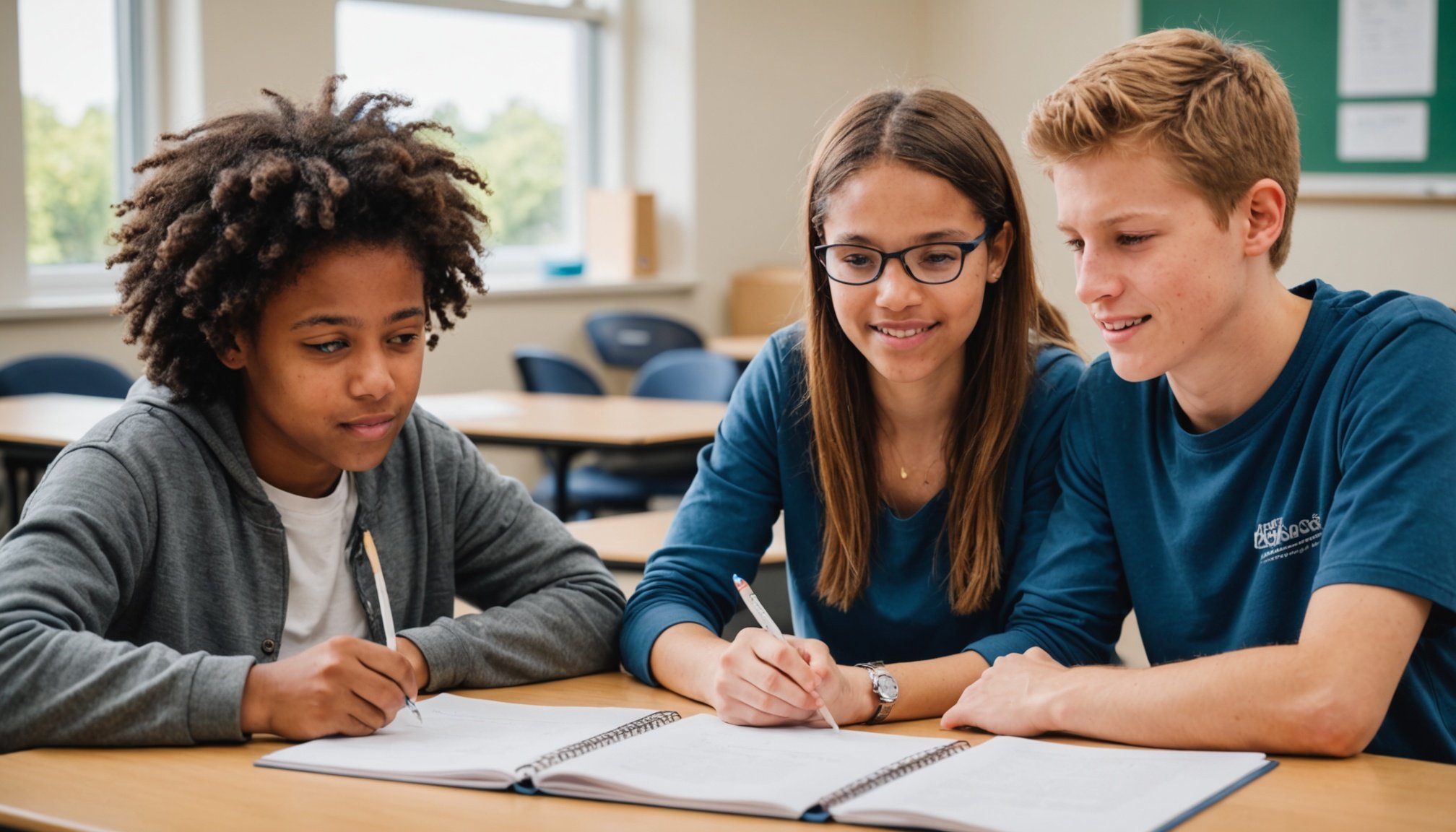Unpacking the Effects of Peer Tutoring on Student Anxiety and Academic Achievement in Educational Settings to Peer Tutoring
Peer tutoring, a method where students are paired with peers who act as tutors, has been a topic of increasing interest in educational research. This approach not only enhances academic achievement but also has a significant impact on student anxiety and overall educational experience. In this article, we will delve into the effects of peer tutoring on student anxiety and academic achievement, exploring the various factors, studies, and practical implications.
The Impact of Peer Tutoring on Academic Achievement
Peer tutoring has been shown to have a positive impact on academic achievement across various subjects, including mathematics, science, and language arts.
Additional reading : Unlocking the pros and cons of smart inhalers: a comprehensive guide to enhanced asthma management
Key Features of Effective Peer Tutoring
- In-School Delivery: Studies have highlighted that tutoring sessions held during school hours are more effective than those conducted outside of school. This is because in-school tutoring integrates seamlessly into the student’s daily routine, reducing barriers such as transportation issues and extracurricular commitments[1].
- Smaller Tutor-to-Student Ratios: A smaller tutor-to-student ratio allows for more personalized attention, which is crucial for addressing individual academic needs. This personalized approach helps students feel more connected to the academic content and to their tutors, leading to better learning outcomes[1].
- Consistent Relationships: The development of consistent and supportive relationships between students and their tutors is a critical factor. These relationships can mirror mentoring relationships, enhancing student engagement and attendance. For instance, a study by Lee, Loeb, and Robinson found that students with consistent tutors were less likely to be absent, with a 7.0% decrease in overall absenteeism[1].
Examples and Outcomes
- Mathematics Achievement: A study on reciprocal peer tutoring in electronic and computer fundamentals showed significant improvements in academic achievement. Students who participated in peer tutoring demonstrated better understanding and retention of the material compared to those in direct learning environments[5].
- Special Education: In special education settings, peer tutoring can be particularly beneficial. By pairing students with peers who can provide support and guidance, schools can create inclusive learning environments that cater to diverse needs. For example, a student with learning differences may find it easier to understand and engage with material when explained by a peer rather than a teacher[4].
The Effect of Peer Tutoring on Student Anxiety
Student anxiety is a pervasive issue in educational settings, influenced by various factors including social pressure, transitions, and academic expectations.
Reducing Classroom Anxiety
- Brain-Compatible Strategies: Neuroscientific research suggests that brain-compatible teaching strategies can reduce classroom anxiety. By making lessons relevant to students’ lives and interests, teachers can create a more engaging and less intimidating learning environment. Peer tutoring, when integrated into these strategies, can further enhance student comfort and reduce anxiety[3].
- Social Emotional Support: Peer tutoring provides an opportunity for social emotional support, which is crucial for managing anxiety. When students feel supported and understood by their peers, they are more likely to feel a sense of belonging and self-efficacy. This support can mitigate the negative impacts of stress and anxiety on the learning process[3].
Practical Strategies to Reduce Anxiety
- Structured Unstructured Time: Unstructured times such as lunch and passing periods can be sources of intense anxiety. Schools can mitigate this by providing structured activities or jobs for students during these periods, ensuring they have a sense of purpose and less time to worry[4].
- Private Signals and Advance Questions: For students anxious about class participation, teachers can arrange private signals or assign questions in advance. This allows students to prepare and feel more confident, reducing their anxiety levels[4].
Factors Influencing the Effectiveness of Peer Tutoring
Several factors influence the effectiveness of peer tutoring, including the learning environment, teacher support, and the COVID pandemic’s impact on education.
In the same genre : Unlocking adolescent mental wellness: the surprising benefits of omega-3 rich foods – a thorough guide
Learning Environment
- Inclusive and Supportive Environment: A learning environment that is inclusive and supportive is essential for the success of peer tutoring. Teachers play a crucial role in fostering this environment by promoting positive relationships and providing necessary resources[1].
- Online Learning: The COVID pandemic has accelerated the adoption of online learning. While online platforms present challenges, they also offer opportunities for peer tutoring. For instance, online tutoring sessions can be more flexible and accessible, especially for students with mobility issues or those living in remote areas.
Teacher Support and Training
- Teacher Training: Teachers need training to effectively implement peer tutoring programs. This includes understanding how to pair students, monitor progress, and provide necessary support. A well-trained teacher can ensure that the peer tutoring program is integrated smoothly into the curriculum[1].
- Continuous Feedback: Continuous feedback from teachers is vital for the success of peer tutoring. Regular assessments and feedback help in identifying areas where students need additional support and in adjusting the tutoring approach as needed.
Case Studies and Research Findings
Several studies have provided insights into the effectiveness of peer tutoring.
High-Impact Tutoring Initiative
- A study by Lee, Loeb, and Robinson on the OSSE High-Impact Tutoring (HIT) Initiative in the District of Columbia found significant reductions in absenteeism among students who received high-impact tutoring. Middle school students and those with extreme absenteeism rates showed particularly strong improvements, with a 13.7% and 7.0% decrease in absenteeism, respectively[1].
Reciprocal Peer Tutoring
- The study on reciprocal peer tutoring in electronic and computer fundamentals highlighted that this method generally improves academic achievement. Students in the peer tutoring group demonstrated better performance and higher overall satisfaction compared to those in direct learning environments[5].
Table: Comparison of Peer Tutoring and Traditional Learning Environments
| Aspect | Peer Tutoring | Traditional Learning Environment |
|---|---|---|
| Personalized Attention | Smaller tutor-to-student ratios allow for more personalized attention | Larger class sizes often limit personalized attention |
| Learning Outcomes | Significant positive impact on academic achievement, especially in subjects like mathematics and science | Variable outcomes, often dependent on teacher quality and class size |
| Student Engagement | Higher student engagement due to peer support and relevant learning experiences | Can be lower due to lack of personal connection and relevance |
| Anxiety Reduction | Reduces classroom anxiety by providing social emotional support and a sense of belonging | May not address anxiety directly, potentially exacerbating it |
| Flexibility | Can be adapted to online learning environments, offering flexibility | Traditionally more rigid, though some flexibility with online integration |
| Teacher Role | Teachers act as facilitators and monitors, providing necessary support | Teachers are primary instructors, with less focus on peer interaction |
Practical Insights and Actionable Advice
For educators and parents looking to implement or enhance peer tutoring programs, here are some practical insights and actionable advice:
Creating a Supportive Learning Environment
- Encourage Positive Relationships: Foster an environment where students feel comfortable and supported by their peers. This can be achieved through team-building activities and promoting positive interactions.
- Provide Necessary Resources: Ensure that both tutors and students have access to the necessary resources, including materials, technology, and feedback mechanisms.
Addressing Student Anxiety
- Identify Anxiety Triggers: Understand the specific factors causing anxiety in students, such as social pressure or transitions, and develop strategies to mitigate these issues.
- Use Brain-Compatible Strategies: Implement teaching strategies that reduce classroom anxiety and increase student connection to their lessons. This can include making lessons relevant and engaging.
Integrating Peer Tutoring into the Curriculum
- Incorporate Peer Tutoring into School Hours: Schedule peer tutoring sessions during school hours to ensure better attendance and integration into the daily routine.
- Train Teachers: Provide teachers with the necessary training to implement and monitor peer tutoring programs effectively.
Peer tutoring is a powerful tool in educational settings, offering significant benefits in terms of academic achievement and student anxiety reduction. By understanding the key features of effective peer tutoring, addressing the factors that influence its effectiveness, and implementing practical strategies, educators can create a more supportive and engaging learning environment.
As Monica G. Lee, Susanna Loeb, and Carly D. Robinson noted in their study, “When students meet with a consistent tutor frequently over the course of the school year, they can develop supportive relationships which can lead to a greater sense of belonging in the classroom”[1]. This sense of belonging and support is crucial for reducing anxiety and enhancing academic outcomes.
In conclusion, peer tutoring is not just an additional educational strategy; it is a holistic approach that addresses the social, emotional, and academic needs of students. By embracing this method, we can create a more inclusive and supportive education system that benefits all students.
List of Key Takeaways
- Personalized Attention: Peer tutoring provides personalized attention, which is crucial for addressing individual academic needs.
- Reduced Absenteeism: High-impact tutoring can reduce absenteeism, especially among middle school students and those with extreme absenteeism rates.
- Brain-Compatible Strategies: Implementing brain-compatible teaching strategies can reduce classroom anxiety and increase student engagement.
- Supportive Relationships: Consistent relationships between students and their tutors can enhance student engagement and attendance.
- Flexible Learning: Peer tutoring can be adapted to online learning environments, offering flexibility and accessibility.
- Teacher Support: Teachers play a critical role in implementing and monitoring peer tutoring programs, requiring necessary training and support.
- Addressing Anxiety: Identifying and addressing specific anxiety triggers, such as social pressure and transitions, is essential for reducing student anxiety.
By considering these takeaways and integrating peer tutoring into educational practices, we can create a more effective, engaging, and supportive learning environment for all students.

